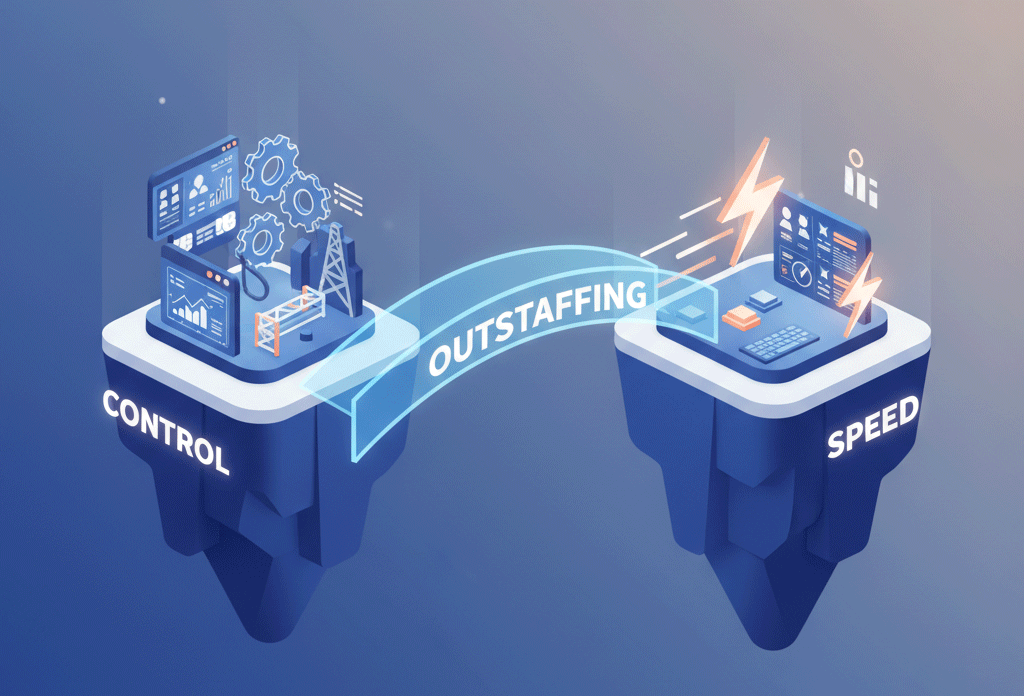
Control vs. Speed: Do You Really Have to Choose?
For many tech leaders, outsourcing feels like a trade-off. You gain speed and specialized talent, but risk losing control over your product and culture.
Here’s the good news: it doesn’t have to be all or nothing.
If you’re not ready to hand over entire projects, outstaffing services give you the best of both worlds. You stay in charge of your roadmap and standards, while extending your team with skilled developers who work as a natural part of it. Outstaffing is becoming the go-to model for startups and growing tech companies that want to scale their teams fast without giving up control.
Learn how outstaffing services help tech companies scale software teams fast without losing control, and why this model is reshaping outsourcing across Europe.
Market Pulse: Why Outstaffing Is Gaining Momentum
The global outsourcing and outstaffing market is expected to surpass $900 billion by 2027 (Statista, Grand View Research). But the trend is shifting, from outsourcing full projects to integrating external developers directly into internal teams.
Across Europe, startups and SMEs now choose outstaffing to balance quality, cultural alignment, and cost, building long-term hybrid teams that deliver consistently.
That’s why nearshore partners like Pharos Solutions are helping European tech companies blend in-house control with global scalability.
Outstaffing vs. Outsourcing: What’s the Real Difference?
At first glance, both models involve external talent. But the control, collaboration, and management structure make them fundamentally different:
Outsourcing
You hand over an entire project or process to another company. The external team manages the workflow, deliverables, and deadlines, often with limited visibility for you.
Outstaffing
You hire individual specialists or full teams from a partner company, but you manage them directly, just like your internal employees.
Feature | Outsourcing | Outstaffing |
Control | The vendor manages the project | You manage the developers directly |
Delivery | Done by an external team | Done by your extended team |
Speed | Fast for complete projects | Fast for scaling your existing team |
Cultural Fit | Varies by vendor | Aligned with your company culture |
Costs | Often project-based | Pay only for dedicated talent |
Flexibilität | Limited mid-project changes | High, easy to scale up or down |
In simple terms, outsourcing gives you results, outstaffing gives you people.
That distinction is key for companies that want to retain control over the product roadmap, ensure culture alignment, and scale up without long-term hiring risks.
Why More Companies Are Turning to Outstaffing
According to Deloitte, over 70% of global businesses now rely on external talent models to close skill gaps and speed up delivery cycles.
Many tech leaders hesitate to outsource fully, and for good reasons:
- They want visibility into day-to-day progress.
- They need developers aligned with internal quality standards.
- They fear communication gaps and delivery surprises.
- They don’t want dependency on a vendor.
Outstaffing solves these challenges by letting you stay in the driver’s seat. You manage priorities and technical direction, while your partner handles HR, contracts, and payroll.
The Benefits of Outstaffing Services
Outstaffing combines flexibility with control, here’s why it works for modern software teams:
1. Access to Specialized Talent, Fast
With access to global and nearshore development teams, you can find the right expertise without being limited by local shortages. Outstaffing connects you to a vetted pool of professionals ready to join your team within days, not months. Gartner reports that companies using outstaffing models accelerate project timelines by up to 30%.
2. Cost Efficiency Without Compromise
Hiring full-time developers in Europe often comes with high recruitment and operational costs. With outstaffing, you gain experienced engineers at competitive rates, while your partner company handles HR, contracts, and infrastructure.
3. Full Control and Seamless Integration
Unlike outsourcing, where management is external, outstaffing keeps control in your hands. You assign tasks, set priorities, and monitor progress directly, ensuring transparency and alignment at every stage.
4. Flexibility to Scale Up or Down
Whether it’s a product launch, a funding round, or a temporary capacity spike, you can scale your team size based on project needs. This agility protects your company from the risks of overhiring or slow ramp-downs.
5. Reduced Risk
You’re not handing over ownership, you’re extending your team. The product, IP, and decisions stay with you.
The Other Side: Risks and How to Mitigate Them
Like any collaboration model, outstaffing comes with its own set of challenges. But what truly matters isn’t whether challenges exist; it’s how they’re handled. When managed right, each potential risk can actually become an opportunity to build stronger, more resilient teams.
1. Communication across time zones
Misaligned hours slow feedback and decisions, eventually affecting delivery speed.
The key? Finding a partner that works with overlapping hours, ensures real-time communication, and integrates seamlessly into your workflows.
2. IP and data security
When external developers handle critical code or sensitive data, the risk of breaches or compliance issues grows. This can threaten not only project confidentiality but also your company’s reputation. That’s why choosing a partner with EU-level data protection standards and signed NDAs across all teams isn’t optional, it’s essential.
3. Management overhead
External talent can mean extra coordination if not managed well draining your team’s energy instead of extending capacity.
With a well-organized partner, management shouldn’t increase, it should simplify. The right tools, onboarding processes, and clear performance metrics make distributed teams feel like part of your in-house structure.
4. Cultural differences
Even strong technical skills can’t compensate for a cultural mismatch. Misunderstandings, different communication styles, or conflicting expectations can erode trust and slow collaboration. That’s why it’s crucial to find a partner who can truly bridge cultural gaps, one who values cultural alignment and collaboration and has proven experience working with companies in your market. That alignment makes remote cooperation feel natural, not forced.
5. Onboarding friction
Every new team member, no matter how skilled, needs time to adapt. Without proper onboarding, productivity dips and project flow stalls. That’s why structured onboarding plans, shadowing periods, and continuous support help external teams become productive from day one.
The Real Solution: The Right Partner Changes Everything
Scaling through outstaffing isn’t just about adding more people; it’s about finding the right people through the right partner. Without a trusted partner, projects lose focus, communication falters, and accountability blurs.
A strong outstaffing partner does more than supply talent; they create continuity, protect your culture, and make collaboration effortless. That’s where the difference between success and burnout lies.
Many companies turn to freelancers for flexibility, but the experience can often be unpredictable, from shifting availability to limited commitment and scattered communication. Outstaffing services, on the other hand, bridge the gap between flexibility and control, letting companies access skilled developers who work like your in-house team. It’s the ideal middle ground in the ongoing debate of outstaffing vs outsourcing, giving you the scalability of an external team with the ownership of an internal one.
When Outstaffing Makes the Most Sense
Outstaffing fits best if your company:
- Has an established product and tech leadership
- Needs to scale development capacity quickly
- Values cultural alignment and collaboration
- Handles sensitive IP or projects that require tight control
It’s a smart move for startups that need flexibility without compromising quality or culture
How Pharos Solutions Helps You Scale Smarter
With over 14 years of experience, Pharos Solutions has been helping European tech companies scale smarter through our proven German-Egyptian collaboration model. We combine European-quality standards with cost efficiency, ensuring cultural and time-zone alignment that makes remote cooperation seamless.
Our outstaffing services are designed to help you scale your software teams without losing control or focus. You stay in charge of your roadmap and delivery, while we handle everything that slows you down.
We help you:
- Hire pre-vetted talent specialized in your tech stack
- Onboard within days, not months
- Maintain continuous communication and full transparency
- Fokus auf core delivery, while we take care of admin, HR, and logistics
- Build long-term partnerships, not short-term gigs
Whether you’re building AI-driven platforms, SaaS products, or complex enterprise software, our dedicated engineers integrate directly into your systems, follow your agile rituals, and work in full alignment with your business goals.
At Pharos, outstaffing feels in-house, helping you move faster, stay flexible, and scale without compromise.
Explore our Outstaffing Services to see how we can help you build your next high-performing development team.
Final Thoughts
Outstaffing isn’t just a hiring shortcut; it’s a strategic way to build resilient, high-performing teams. By combining external flexibility with in-house control, companies can move faster and scale without burnout.
If you’re looking to extend your development team or explore flexible collaboration models, let’s talk about how Pharos can help you grow confidently.
Questions You May Have About Outstaffing Services
What is the difference between outstaffing and outsourcing?
Outsourcing means assigning an entire project to an external company that manages everything, from planning to delivery.
Outstaffing, on the other hand, lets you extend your in-house team with external developers who work under your direction, using your tools and following your processes. You keep full control over quality, priorities, and culture.
How does outstaffing help scale software teams faster?
With outstaffing, you can onboard skilled developers in a matter of days instead of months. The partner company provides pre-vetted professionals ready to integrate immediately, so you skip the lengthy hiring, training, and onboarding steps while staying in full control of project delivery.
Is outstaffing suitable for startups or only for large enterprises?
Outstaffing is especially valuable for startups and growing tech companies. It gives you the freedom to scale your team up or down quickly, access top-tier talent at competitive costs, and stay agile without long-term hiring risks. Larger enterprises also use it to expand capacity for specific projects or technologies.
What makes outstaffing better than hiring freelancers?
Freelancers offer short-term flexibility but often lack consistency, long-term commitment, and integration into your workflows.
Outstaffed developers, however, become part of your extended team, they follow your agile rituals, share your culture, and stay dedicated for as long as you need them. You get flexibility und reliability in one model.


